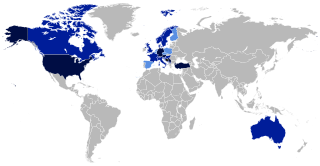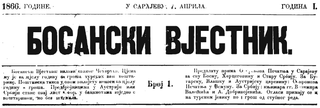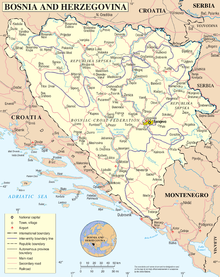
Bosnia and Herzegovina is a country in Southeast Europe, situated on the Balkan Peninsula. It borders Serbia to the east, Montenegro to the southeast, and Croatia to the north and southwest. In the south it has a 20 kilometres long coast on the Adriatic Sea, with the town of Neum being its only access to the sea. Bosnia has a moderate continental climate with hot summers and cold, snowy winters. In the central and eastern regions, the geography is mountainous, in the northwest it is moderately hilly, and in the northeast it is predominantly flat. Herzegovina, the smaller, southern region, has a Mediterranean climate and is mostly mountainous. Sarajevo is the capital and the largest city.

Bosnian, sometimes referred to as Bosniak language, is the standardized variety of the Serbo-Croatian pluricentric language mainly used by ethnic Bosniaks. Bosnian is one of three such varieties considered official languages of Bosnia and Herzegovina, along with Croatian and Serbian. It is also an officially recognized minority language in Croatia, Serbia, Montenegro, North Macedonia and Kosovo.

The Sarajevo Canton, officially the Canton of Sarajevo, is one of the ten cantons of the Federation of Bosnia and Herzegovina in Bosnia and Herzegovina. Its cantonal seat is the city of Sarajevo, also the capital city of Bosnia and Herzegovina.

Trebinje is a city and municipality of Bosnia and Herzegovina, located in the Republika Srpska entity. It is the southernmost city in Bosnia and Herzegovina and is situated on the banks of Trebišnjica river in the region of East Herzegovina. As of 2013, it has a population of 31,433 inhabitants. The city's old town quarter dates to the 18th-century Ottoman period, and includes the Arslanagić Bridge, also known as Perovića Bridge.

The Catholic Church in Bosnia and Herzegovina is a part of the worldwide Catholic Church under the spiritual leadership of the pope in Rome.

The Republika Srpska was a self-proclaimed statelet in Southeastern Europe under the control of the Army of Republika Srpska during the Bosnian War. It claimed to be a sovereign state, though this claim was only partially recognized by the Bosnian government in the Geneva agreement, the United Nations, and Yugoslavia. For the first six months of its existence, it was known as the Serbian Republic of Bosnia and Herzegovina.

Bosnia is the northern region of Bosnia and Herzegovina, encompassing roughly 81% of the country; the other region, the southern part, is Herzegovina.

The Republic of Bosnia and Herzegovina was a state in Southeastern Europe, existing from 1992 to 1995. It is the direct legal predecessor to the modern-day state of Bosnia and Herzegovina.

The Socialist Republic of Bosnia and Herzegovina, commonly referred to as Socialist Bosnia or simply Bosnia, was one of the six constituent federal states forming the Socialist Federal Republic of Yugoslavia. It was a predecessor of the modern-day Bosnia and Herzegovina, existing between 1945 and 1992, under a number of different formal names, including Democratic Bosnia and Herzegovina (1943–1946) and People's Republic of Bosnia and Herzegovina (1946–1963).

The following outline is provided as an overview of and topical guide to Croatia:

The following outline is provided as an overview of and topical guide to Montenegro:

The following outline is provided as an overview of and topical guide to Serbia:

The identity card of Bosnia and Herzegovina is a compulsory identity document issued in Bosnia and Herzegovina. All citizens of Bosnia and Herzegovina who are residents of Bosnia and Herzegovina and are over the age of 15 have the right to apply for the national ID card; nevertheless, all citizens of Bosnia and Herzegovina that are over the age of 18 must have an identity card issued by the police by the city of residence.

Herzegovina is the southern and smaller of two main geographical regions of Bosnia and Herzegovina, the other being Bosnia. It has never had strictly defined geographical, cultural or historical borders, nor has it ever been defined as an administrative whole in the geopolitical and economic subdivision of Bosnia and Herzegovina.
This is a survey of the postage stamps and postal history of Bosnia and Herzegovina.

Bosnians are people native to the region Bosnia in the country of Bosnia and Herzegovina, especially the historical region of Bosnia. As a common demonym, the term Bosnians is wrongly used to refer to all inhabitants/citizens of the country, regardless of any ethnic, cultural or religious affiliation. It can be used as a designation for anyone who is descended from the region of Bosnia.

The following outline is provided as an overview of and topical guide to Republika Srpska:

The Vilayet Printing House, originally named Sopron's Printing House, was the official printing house of the Ottoman Vilayet of Bosnia from April 1866 until the occupation of the province by Austria-Hungary in August 1878. It was the second printing house that operated in the territory of present-day Bosnia and Herzegovina, founded in Sarajevo almost 350 years after the Goražde printing house ceased its activity. Its founder was Ignjat Sopron, a publisher and printer from Zemun, who sold the establishment to the Government of the Vilayet of Bosnia in October 1866. Its foundation happened in the context of modernising and Europeanising Tanzimat reforms in the Ottoman Empire. Its principal aim was to issue an official gazette of the vilayet and publish textbooks for the elementary schools of Bosnian Serbs and Croats, thus stopping their import from the Principality of Serbia and the Austrian Empire.

The name of Bosnia is commonly used in English language as an exonym Bosnia, representing the South Slavic common endonym Bosna. The name was first recorded during the 10th century, in the Greek form Βόσονα, designating the region. In following centuries, the name was used as a designation for a Bosnian medieval state. After the Ottoman conquest in 1463, the name continued to be used as a designation for the Sanjak and Eyalet of Bosnia. After the Austro-Hungarian occupation in 1878, the region of Bosnia was reorganized and the name of its region of Herzegovina incorporated into the dual name of Bosnia and Herzegovina.
Central Bosnian culture was a cultural group that emerged during the Bronze and Iron Ages. This group inhabited the upper and mid course areas of the Vrbas river and the Bosna river, and constituted an independent cultural and ethnic community. Hillfort-type settlements were typical of this group and were often located close to major areas of cultivable land. The standard of housing in these settlements was high. Around 120 hill forts belonging to this culture have been identified in the area of Central Bosnia. This group is commonly associated with the later Illyrian tribe of Daesitiates.























